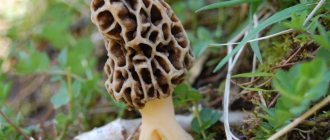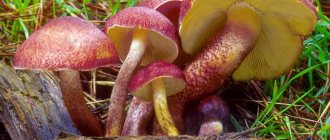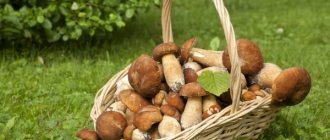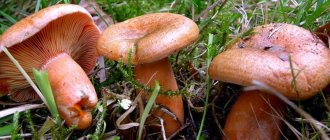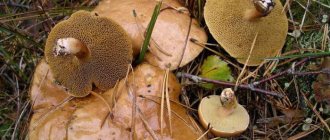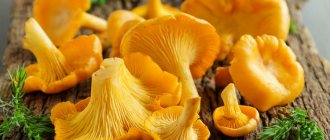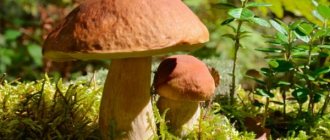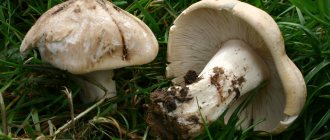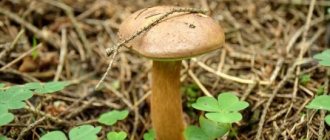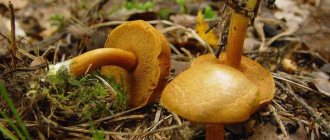A huge variety of mushrooms grow on the territory of Russia. Some species can be collected in early spring, others closer to autumn. Stitches can be found in the forest area. Mushrooms are not safe for inexperienced foragers. They can easily be confused with morels. There is no unanimous opinion among experts regarding their toxicity. Some believe that no heat treatment destroys the poison of mushrooms, others believe that after appropriate processing they can be eaten. Russian sanitary doctors classify them as conditionally edible mushrooms.
Description
Stitch mushrooms (photo in the text) can be compared in appearance to a crumpled sheet of brown paper. The fruit body is very unattractive, crooked and asymmetrical, with deep clumsy wrinkles, reminiscent of hanging crumpled rags.
Strog belongs to the genus of marsupial fungi of the Discinaceae family. Organisms that have septate mycelium and specific organs of sexual sporulation - asci - are classified as ascomycetes (translated from Greek as “bag”). That is why the stitch is called a marsupial mushroom. This group includes up to 20,000 genera and 30,000 species, including yeast, morels, truffles, and Parmelia lichen.
It is not for nothing that they are confused with morels - they are very similar in appearance. Only the caps are even more curved and covered with deep curved grooves. Each can have up to four vertices. Its size is usually 2-6 cm, the diameter at the bottom can reach 10 cm. The color is black-brown or yellow-brown, the surface itself is velvety. It is curious that the “elevations” do not have hairs, but in deep (up to 0.5 cm) furrows they are present. The lower part of the cap in some places fuses with the stem. The thin and tender flesh matches the external color in color.
The stems of the mushrooms have irregularly shaped stitches with a slight thickening at the bottom, do not exceed six centimeters in height, up to three centimeters in width, the color is reddish, sometimes with a white tint. The leg is deepened into the ground, its surface can be absolutely smooth or pitted with depressions and pits. Some are completely covered with soft down, some are completely naked. The pulp is without a pronounced mushroom smell, fragile, light.
Characteristic
The description of the mushroom includes several distinctive qualities:
- the cap is shapeless or irregularly ovoid, with a wavy surface characterized by random folding (resembling the convolutions of the brain or the surface of a peeled walnut), 8-10 cm in diameter, filled with tortuous pulp inside;
- the surface is velvety, the shape is asymmetrical;
- the cap smoothly transitions to the lower part;
- in young specimens the color is dark brown or chestnut, adults are lighter;
- the stem is practically absent - very short and merges with the cap, the color of the mushroom stem is whitish or light yellow.
Representatives of the Strochok genus are widespread throughout the world - they can be collected in America, Eurasia and the Northern Hemisphere. An abundance of fruiting bodies is noted in Mexico.
They grow in pine forests near rotten, fallen trees - the main source of organic matter, since mushrooms are saprophytes. Fruiting lasts from April to May.
The lines grow in groups or singly; you need to look for them in environmentally friendly places - away from roads, industrial and gas-polluted areas.
Kinds
Stitch mushrooms in Russia are found mainly of two types: giant and ordinary. In some regions you can find autumn and bunch. They differ not only in appearance, but also in their place of growth:
- common (Gyromitra esculenta), prefers pine forests, fires, clearings and other areas well warmed by the sun;
- giant (Gyromitra gigas), grows in the same place as the ordinary one, but can also be found in coniferous plantings;
- autumn (Gyromitra infula) is found in both deciduous and coniferous forests, growing on the remains of rotting, decaying wood;
- fascicle (Gyromitra fastigiata) can be found in mixed or broad-leaved forests; it loves the remains of rotting wood, especially birch and aspen.
Toxicity
It was already known more than 100 years ago which stitch mushrooms are dangerous. Although at first such poisoning was attributed to an individual allergic reaction of people or it was mistakenly believed that the poisoning was caused by other products. Cases of joint consumption of mushrooms by several people have been described. At the same time, some suffered from severe intoxication, others felt absolutely normal. Many experienced mushroom pickers consider string mushrooms edible; for many years they have been collecting them and eating them without any consequences.
The study of toxins contained in ordinary lines began in the middle of the last century. Recent biochemical studies have shown that these mushrooms are poisonous and deadly. It is curious that the degree of toxicity of the mushroom depends on the growing zone; the warmer the climate, the higher the level of toxins. Poisoning is provoked by gyromitrine, its lethal dose is:
- children – 10-30 mg per 1 kg of weight;
- adults – 20-50 mg.
This dose can be obtained from eating from 200 grams to 1 kg of fresh mushrooms (depending on the climate zone). The body's individual resistance to the toxin can dramatically increase or, conversely, reduce the risk of using stitches. Recent statistics show that cases of gyromitrine poisoning are extremely rare in North America and Europe. They are most often observed in Eastern Europe and Scandinavia. Polish scientists have found that in relation to the total number of mushroom poisonings in the country, lines account for 23% of cases. Fatal poisonings have recently decreased significantly, this is explained by the correct processing of mushrooms. The European average mortality rate is still high – up to 25%.
Symptoms of poisoning are divided into gastrointestinal and neurological. Signs can appear on average after 6-12 hours. There are known cases of their manifestation after two hours. First signs:
- facial redness;
- diarrhea;
- nausea;
- stomach pain.
As the situation worsens, tremors, lethargy, convulsions, ataxia, severe headaches and dizziness appear. Fever is not a characteristic symptom of poisoning with other types of mushrooms; it manifests itself exclusively as a symptom of intoxication with strings. In the vast majority of cases, such manifestations disappear after a couple of days or within a week. Particularly severe cases are accompanied by destruction of the liver and kidneys, and neurological dysfunction, even coma, may occur. Serious damage to internal organs can lead to death 5-7 days after the first signs of poisoning appear.
Are the lines poisonous or not?
Rice. 1. Molecule of gyrometrin - the main toxin that determines the poisonous properties of string mushrooms.
Meet, this is gyrometrine . The same poison that is contained in the lines. In general, it itself is unstable and quite quickly hydrolyzes to a more stable, but by no means less poisonous methylhydrazine (see picture below).
Rice. 2. A molecule of methylhydrazine (also known as monomethylhydrazine) is a substance that can be poisoned by eating stitches.
Well, we are dealing with a derivative of the famous hydrazine - a terribly toxic substance that has been used as a component of rocket fuel since World War II (methylhydrazine too, by the way).
But, I digress.
And just imagine - this rubbish is contained in the mushrooms that people eat! I won’t go into details (I don’t want, as they say, to spoil your mood and appetite) - how the line toxin “makes noise” in the body, I will only say one thing - it “works” powerfully, destructively and “on two fronts” at once. It poisons a person both in the short and long term. That is, it can relatively quickly cause symptoms of poisoning, or it can accumulate in the body and wait in the wings for years - like a time bomb.
The most unpleasant thing here is that the concentration of gyrometrin in the lines can be completely different - from minimal to lethal. Or even go off scale - so much so that boiling or drying mushrooms will be useless. And the amount of poison in mushrooms can only be determined in the laboratory.
Mycologists - both ours and foreign ones - have been studying this topic for a long time, but have not yet come to common conclusions. Nevertheless, some patterns were still identified.
First: the concentration of gyrometrin depends on the species (or even the specific population) of the line. In an ordinary line it, apparently, can reach a decent level. In a giant line, it seems like there is less toxin concentrated, and some authors even say that there is no gyrometrin there (but you shouldn’t delude yourself about this, since there is no final conclusion on this topic from science yet).
Secondly: it has been noticed that they are consistently poisoned by strings collected in the autumn: either those from the spring that provide a “second layer” for the fall, or those that bear fruit like typical autumn mushrooms. Progressive mycologists believe that during the summer the mycelium is capable of producing the maximum amount of poison. And it is quite possible that spring may influence this, especially if it is abnormally warm.
Thirdly: geographical location (and altitude above sea level) also seems to affect the concentration of gyrometrin. What is the primary factor here? Probably the climate. It has been noticed that in Western Europe and in southern latitudes, stitches are etched more often. But in the north they are eaten, and some especially “brave” mushroom pickers eat them without first boiling them, and they don’t blow them (again, in their words).
Fourth: different people may have different reactions to gyrometrine. There are examples when particularly crazy collectors devoured the lines raw - and, it seems, there was nothing for them (although, again, given the long-term effect of the poison, these “experimenters” were most likely mistaken). Others were seriously poisoned by mushrooms prepared according to all the rules.
Also worth noting is the fact that some researchers have found an uneven distribution of toxins in the stitching itself. So, there were fewer of them in the cap than in the leg.
In simple terms, science has managed to find out something about the toxicity of the lines, but there are still quite a few gaps in this topic .
The toxicity of the lines can also be influenced by the environmental situation in the place where they grow. It has been noticed that mushrooms accumulate harmful substances better than all other representatives of the biosphere. For example, if absolutely edible russula or boletus grow in environmentally unfavorable areas, or happen to be in an area where hazardous chemicals are released, then these mushrooms can be eaten like banal toadstools. The lines here are no exception.
As a result, in some European Union countries, stitches are prohibited for collection, much less for sale. In other countries, for example - in Finland - they are regularly collected and eaten (they also sell mushrooms in supermarkets - like champignons in our country).
Ordinary
Here's what's remarkable about the common string mushroom:
- the cap is wrinkled brown (various shades, becomes lighter with age), the edges at the bottom are fused with the stem (a kind of hollow sac is formed), diameter 2-10 cm;
- the leg is asymmetrical, wrinkled, partially buried in the soil, thickened closer to the base, up to three centimeters long, light, sometimes pink;
- the pulp is white, thin, waxy, brittle, with a faint mushroom odor, and has no special taste;
- grows in groups and singly, found in all forest zones of Russia, with the exception of the Far North;
- collected from the end of March until about mid-June (depending on the climate zone), mushrooms appear like snowdrops immediately after the snow melts;
- classified as medicinal, in the post-Soviet space it is eaten with caution, in some countries it is considered a delicacy;
- distributed in Europe, CIS countries, North America.
Giant
One of the varieties most often found in Russia. Externally, stitches look like ordinary mushrooms, but larger:
- the cap can be colored in all shades of yellow, from pale to brown, up to 30 cm in diameter, completely attached to the stem, the surface is shapeless, wavy-folded;
- the leg is up to 15 cm in height, very wide, watery, hollow, grayish in color, with small irregularities in the form of depressions;
- the pulp is light without a pronounced mushroom smell and taste;
- grows in groups, prefers the proximity of birch trees and fertile soils;
- the timing of mushroom collection is from late April to early June;
- refers to conditionally edible mushrooms, cannot be consumed raw;
- found in mixed forests throughout Russia and southern Finland.
So to collect lines or not to collect?
Photo 12. Giant stitches, collected in the forest on the territory of the Russian Federation. Author: Wolkodlak.
I’ll say right away that I’m not going to recommend anything to anyone, much less advise.
In my area, as well as among all my mushroom pickers, strings are considered those mushrooms that you should not mess with. And the location influenced this choice. The Middle Urals are located between the Northern and Southern Urals. And if to the north of us, perhaps, the strings are collected and eaten, then to the south (for example, in Bashkortostan) there are already statistics on poisoning.
I don't collect the lines myself. If you really want to eat mushrooms in the spring, you can get by with morels, which are quite edible (with proper processing and cooking, of course). Or you can wait until the summer - fortunately, the boletus will start growing in June, and they are certainly safe.
However, if in your area they have been collecting stitches for a long time - and no one is poisoned by them - proceed as you see fit. The main thing is to process the mushrooms correctly . But keep in mind -
Any mushroom picker collects and uses strings, even if properly processed and prepared, at his own peril and risk.
Still, do not forget that with regular use of the lines, methylhydrazine can accumulate unnoticed in the body and subsequently work like a time bomb.
Autumn
It is believed that this variety can be eaten. Autumn line mushrooms (photo and description below) have the fourth category in terms of taste. If the heat treatment is incorrect, there is a risk of poisoning:
- a cap with a diameter of up to 12 cm, irregularly saddle-shaped, velvety, color – all shades of brown, the surface can be smooth or folded, the edges grow to the stem;
- the stem is the same color as the cap, sometimes lighter or with a barely noticeable bluish tint, covered with fine hair, hollow, length up to 10 cm, width up to 3 cm, shape – cylindrical;
- the pulp is light, thin, brittle, cartilaginous, waxy in consistency, and has no distinct odor;
- grows singly and in groups;
- collection time - from July to late autumn, in the southern regions - until November;
- refers to conditionally edible mushrooms, cannot be consumed raw;
- found in the temperate zone of Europe and Russia.
Beam
Another variety is bunch stitches. Mushrooms (described below) are quite rare for Russia; they have not been seen in taiga forests:
- the cap is up to 15 cm in diameter, consists of 2-3 separate plates that have not grown together, the edges do not grow to the stem, the color is shades of red-brown, the surface is coarsely ribbed;
- the leg is massive, dense, with ribbed protrusions, thickened downward, snow-white, hollow inside, height up to 10 cm;
- the pulp is thin, fragile, watery (more elastic in the stem), white or pinkish in color, with a faint, pleasant mushroom smell;
- grows in groups and singly;
- Harvest time: April, peak fruiting occurs in the middle of the month;
- There is no exact information about the toxicity of tufted stitches, but there is an opinion that the content of gyromitrin in it is somewhat less than that of ordinary or giant;
- found everywhere in Europe.
The peculiarity of bunch stitches is that there can be several legs under one head.
Eating
These mushrooms are consumed only after thorough digestion. After half an hour of cooking, the broth must be drained, the mushrooms washed, and boiled again for thirty minutes, drained, simmered, boiled or fried.
These mushrooms can be dried in the oven, this will remove toxicity from them. This treatment evaporates the poison from the mushrooms, and because of this, the toxicity disappears.
The stitches must be dried at a temperature of fifty-five degrees for a long time. It is possible to dry them in the open air, but this will take six months.
Before cooking and drying, mushrooms must be soaked, thereby getting rid of insects and dirt in the folds of the stitches.
Benefit
There is such a term - fungotherapy, or mushroom treatment. In practice, it is not used very often, but recently this area of traditional medicine has been developing rapidly. Stitch mushrooms have a number of beneficial properties due to the presence of various chemical compounds in them:
- increase appetite;
- “work” as a pain reliever;
- tone;
- help with neuralgia;
- used in the treatment of glaucoma, myopia, cataracts, farsightedness;
- improve digestion;
- stimulate the pancreas.
The analgesic properties of stitches were used in ancient times for toothache, joint and muscle pain. A rubbing tincture prepared from them is used for various diseases of the musculoskeletal system, radiculitis, arthritis, and osteochondrosis. Tissue inflammation is relieved, and their regeneration occurs faster. For inflammation of the respiratory tract, use a tincture to rub the chest. Use internally only as prescribed by a doctor in a strictly defined dosage.
Preparation of alcohol tincture:
- the stitches are dried and crushed;
- 2.5 tablespoons of raw material are poured into 500 ml of vodka;
- The container with the liquid is carefully closed and stored in the refrigerator for two weeks.
The unstrained tincture is ready for external use. After rubbing, it is recommended to wrap the treated area with a woolen cloth. The procedure is repeated until pain disappears or recovery occurs.
Beneficial features
Mushrooms contain many beneficial substances
Stitch mushrooms are useful, like other forest gifts. The pulp contains useful compounds such as pectin and chitin. Apothecium also contains vitamins A, PP, group B, micro- and macroelements:
- calcium;
- magnesium;
- sodium;
- phosphorus;
- manganese;
- copper.
This set of vitamins and minerals is good for vision, hair, and nails. They note beneficial properties for the cardiovascular system, immunity, nervous system, and gastrointestinal tract. Oleic acid (22 mg per 100 g) is beneficial for intestinal motility.
Pectin has a cleansing effect. Thanks to chitin, the pulp takes a long time to digest and quickly satisfies the feeling of hunger. Forest species are low in calories - 30 kcal per 100 g. The main part of the pulp is water. Mushrooms of the genus Strog are rich in proteins.
Harm
Stitch mushrooms (photo in the article) for any type of heat treatment are contraindicated for certain categories of people:
- pregnant and lactating women;
- for serious problems with blood vessels and heart;
- for any problems with the gastrointestinal tract;
- kidney diseases;
- individual acute reaction of the body;
- children under 12 years of age.
When gyrometrine enters the body, the kidneys are the first to be affected and can cause kidney failure. Boiling and drying do not completely destroy gyrometrin, its concentration simply decreases. It is impossible to determine the content of this “poison” in mushrooms by eye; if there is the slightest doubt, it would be safer to refrain from eating a mushroom dish. As a last resort, eat a minimal portion and listen to your body. Improper preparation of mushrooms is almost 100% guaranteed to cause nausea, diarrhea, vomiting, abdominal pain, fever and even fainting.
How mushroom pickers try to remove toxins from stitches
Well, first of all they boil it. At least 15 minutes (although it’s probably better - longer, up to half an hour), with the obligatory throwing away of the broth and washing the mushrooms in clean water. Some mushroom pickers repeat this procedure. Americans advise doing this more than twice, after chopping the mushrooms into small pieces, suddenly - always with good ventilation (and this is by no means paranoia - hydrazine derivatives are dangerous not only in the broth, but also in the air).
Some mushroom pickers soak the stitches for a long time (several hours) before boiling.
However, as practice has shown, long-term drying removes toxins more effectively than boiling (in which, by the way, the poison still remains in some quantities). But you need to keep mushrooms for at least six months, in the fresh air. Studies have also shown that the higher the temperature during drying, the better gyrometrin evaporates.
Alas, the concentration of gyrometrin in mushrooms may be very high - then all the methods described above will not help.
Cooking
To the question whether it is possible to eat string mushrooms, the answer is yes. In Europe and North America, despite their proven toxicity, they are considered a delicacy. Young mature mushrooms are collected for drying and boiling in Finland, Spain, Bulgaria and other countries, including Russia. At the same time, the official sale of stitches is prohibited in Germany, Italy, Switzerland, Sweden and Russia. An interesting fact is that Russian mushrooms contain less toxic substance, apparently due to the lack of heat.
In France they are grown artificially. The method is simple and can be used at home:
- choose a sunny area;
- they collect leaves, dead wood, and unnecessary wood in a heap;
- they burn everything;
- cut pieces of stitching are scattered on the ashes;
- The first few mushrooms are expected to appear next April; a bountiful harvest can be harvested in 5 years.
Scientists have an unequivocal verdict - you can’t eat raw stitches. After appropriate processing, it is an excellent product with a delicate taste and pleasant aroma. Experienced chefs advise to approach mushroom preparation responsibly:
- Rinse the mushrooms thoroughly with cold water, remove debris and soil;
- prepared mushrooms are poured with water at the rate of 3 liters per 1 kg;
- the product is boiled for at least 20 minutes;
- the water is drained, the mushrooms are washed in running water;
- repeat cooking the lines;
- drain the water again and rinse again under running water.
Be sure to cook in an open container and with the window open. During the heat treatment, toxic substances are released. Now the mushrooms are ready for further use - frying, drying, canning. String mushrooms that have become edible (photo of the dish in the text) are used to prepare soups, main courses, appetizers, sauces, and as a filling for baked goods. However, it is worth noting that if you are not sure that the mushrooms are cooked correctly, it is better to avoid eating them.
The future of collecting and using stitches
Photo 13. Risotto with lines, prepared somewhere in Finland.
Everything that follows is nothing more than the author’s free imagination on the topic of the not very distant future. You shouldn't take them seriously. Although…
Lines - mushrooms are very tasty, and no matter how you look at them, sooner or later they will have to take their rightful place among food products.
I suppose that someday genetic engineering will produce a genetically modified breed of stitches that will not contain gyrometrin at all. Or mushroom growers will learn to cultivate them correctly, so that poison simply does not form.
There is a possibility that they will invent some kind of chemical indicator that will show the presence of poison in the lines (and indeed in any mushrooms). Imagine this picture: a mushroom picker went mushroom picking and took a small device with him. I found a line, poked it with a probe - two stripes appeared. This means it’s better to avoid the mushroom. I checked another mushroom - one stripe. This means you can take it, but you will have to boil it. And the third mushroom didn’t show any stripes at all - therefore, it can be cooked right away. Fantastic? It seems to me quite feasible, but in about a hundred years.
Well, or they synthesize an antidote to line toxins. Perhaps these will be tablets - which will need to be eaten before use, or just a drug - which will need to be added to the water before boiling the mushrooms. But this has already become outright science fiction.
Perhaps we won’t have to wait long for any of the above, since science is now developing at a Stakhanov pace.
